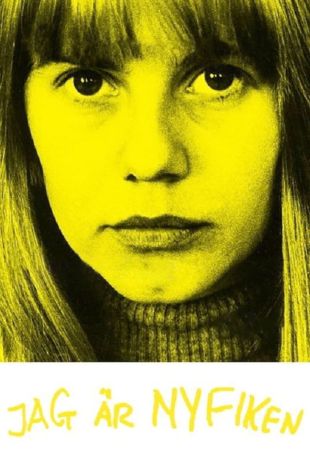Best known for 1968's twin arthouse succès de scandales I Am Curious (Yellow) and I Am Curious (Blue), Swedish writer/director Vilgot Sjöman sustained a long and varied career as a filmmaker -- a fact generally overlooked by cinephiles on the near side of the Atlantic, where the majority of his features (sadly) fell through the cracks of distribution, evading cinematic and video release.
In his early days, Sjöman struggled as an aspiring playwright, to such a degree that he failed to find backing for any of his theatrical pieces (or producers with any interest in mounting them). He nonetheless carved alternate roads to success -- and reworked one of his plays as a novel, which he later adapted as a movie screenplay for Trots/Defiance (1952), directed by Gustaf Molander. Its triumph inspired the 28-year-old Sjöman to eschew theater for cinema, and in 1956 he high-tailed it to Los Angeles, with a scholarship to UCLA under his arm. He enrolled in a six-month film course and subsequently returned to Sweden.
1962 marked two key events in the filmmaker's life: Sjöman's initial directorial bow, with the feature film The Swedish Mistress, and his collaboration with mentor Ingmar Bergman on Winter Light -- an endeavor about which he later published a book, L136: Diary with Ingmar Bergman.
The title of Sjöman's sophomore effort, 491 (1964) refers to the biblical passage in which Jesus proclaimed that each man will be forgiven "seventy times seven" (or 490 times); the tagline read, "This movie is about the 491st." Its premise involves a pack of juvenile delinquents who participate in a social experiment. The authorities encourage them to engage in all manner of antisocial behavior, sans punishment, on the grounds that they report their activities in detail to several "experimenters" on a nightly basis. The teenage participants indulge in sodomy, bestiality (one rapes a dog out-of-shot), and uninhibited sex with a prostitute; one of the researchers, a homosexual, later molests two of the boys and blackmails them from telling the police. 491 incited a worldwide furor; Swedish authorities banned and later imposed censorship cuts on Sjöman's harrowing study of humankind's vile impulses.
With My Sister, My Love (1966) the director later reflected that he "hit a wall" -- he subsequently remarked to an interviewer, "I was trying to do a well-made play, translated into cinematic terms." The Curious films, then, represented Sjöman's (successful) attempts to break out of a rut, stylistically -- to knock down traditional formal barriers in the cinematic medium. Deftly intercutting the frameworks of fiction and cinéma vérité, and housing a film within the film (which Sjöman himself is seen directing, onscreen), the picture humorously recounts the political and sexual emancipation of its young protagonist, Lena Nyman (who plays herself).
Sjöman and Nyman shot I Am Curious (Yellow) in the summer of 1966, and its follow-up, I Am Curious (Blue), thereafter. Yellow brought heated debate to a boil in Sweden and the United States, but for disparate reasons. U.S. Customs officials seized and banned the film on grounds of obscenity (primarily for scenes featuring full-frontal nudity of Lena and her lover, Börje Ahlstedt, simulated lovemaking, and a sequence with Lena kissing and fondling Ahlstedt's genitalia); the comparatively more liberal Swedish courts failed to raise an eyebrow at the sexuality but found the picture's subversive, almost anarchic political leanings horrific. (The shots of Lena and Börje copulating in full view of a Swedish guard probably didn't help, either.) Though by today's relaxed standards the picture feels innocent, even genteel, it spearheaded the sexual revolution in the United States and ultimately led to the full erosion of censorship restrictions on motion pictures; for this reason, the historical value of the film cannot be overestimated. But by opening the floodgates for hardcore porn in the early '70s, Yellow, in its own way, also wiped out a number of New York-area arthouse venues. (Grove Press maven Barney Rosset, who brought Yellow into the States and programmed runs of European features of like nature, asserted that many of those who turned up for his screenings were simply desperate for onscreen sex, and later flocked to porn when XXX-rated features became commonplace -- thus depriving the New York-area arthouse circuit of much of its market.)
None of Sjöman's subsequent features received U.S. release or widespread reference in U.S. periodicals. These, nevertheless, include: Ni Ljuger (1969), a gritty exploration of the Langholm, Sweden prison with the same documentary/fiction stylistic hybrid present in Yellow and Blue; Troll (1971), a wild sex farce about a couple of lovers driven to abstinence by the conviction that intercourse will kill them; Garaget (1975), a study of an affair between a school principal and a cleric's wife that ends in cold-blooded murder; Jag Rodnar (1981), an effort about a director attempting to shoot an adaptation of Joseph Conrad's Victory in the Philippines, but besieged by all sorts of travails, including the forced decision to replace his leading man with Larry Hagman (who plays himself); the 1987 Malacca, a drama about psychiatry culled from Sjöman's own experiences on the couch; and the 1995 Alfred, a biopic on Alfred Nobel, Swedish founder of the Nobel Prize.
Alfred became Sjöman's swan song. He received renewed attention in his final decade, however, with The Criterion Collection's summer 2003 home video release of two of his films -- I Am Curious (Yellow) and I Am Curious (Blue) -- in a box set. After a decade of directorial inactivity, the filmmaker died from a brain hemorrhage on April 9, 2006, at age 81.


